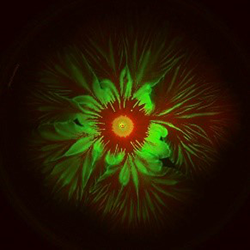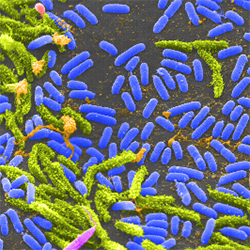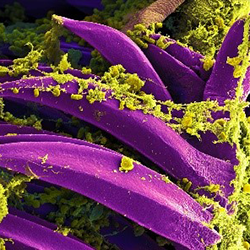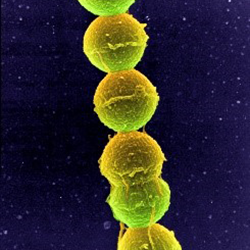Some bacteria benefit us as part of our microbiome—the vast collection of microorganisms that live in and on our bodies—while others can make us sick. Whether helpful or dangerous, bacteria can appear colorful and striking under a microscope. These photos provide just a small peek into the incredible diversity of these microbes.
 Credit: Liyang Xiong and Lev Tsimring, BioCircuits Institute, UCSD.
Credit: Liyang Xiong and Lev Tsimring, BioCircuits Institute, UCSD.
This floral pattern emerged when a researcher grew two strains of bacteria—Acinetobacter baylyi (red) and Escherichia coli (green)—together for 2 days in a petri dish. A. baylyi are found in soil and typically don’t pose a threat to humans, although some strains can cause infections. E. coli normally live in the intestines of people and animals. Most strains are harmless, but some can cause food poisoning or other illnesses.
 Credit: Tina Carvalho, University of Hawaii at Manoa.
Credit: Tina Carvalho, University of Hawaii at Manoa.
The little blue capsules in this image are a type of Vibrio bacteria. A species called Vibrio cholerae causes cholera, a gastrointestinal illness that affects approximately 2.9 million people each year. People typically contract cholera from drinking contaminated water. In industrialized countries like the United States, water treatment systems have virtually eliminated cholera.
 Credit: B. Joseph Hinnebusch, Elizabeth Fischer, and Austin Athman, National Institute of Allergy and Infectious Diseases, National Institutes of Health.
Credit: B. Joseph Hinnebusch, Elizabeth Fischer, and Austin Athman, National Institute of Allergy and Infectious Diseases, National Institutes of Health.
Here, bubonic plague bacteria (yellow) are within the digestive system of a rat flea (purple). The bubonic plague killed a third of Europeans in the mid-14th century. Today, it is still active in Africa, Asia, and the Americas, with as many as 2,000 reported cases of people infected worldwide each year. If caught early, bubonic plague can be treated with antibiotics.
 Credit: Tina Carvalho, University of Hawaii at Manoa.
Credit: Tina Carvalho, University of Hawaii at Manoa.
Each “bead” shown here is a Streptococcus bacterium, a type of spherical bacteria that often occur in pairs or chains. Some species of Streptococcus coexist peacefully with us as part of the human microbiome, but others cause infections such as strep throat, pink eye, and pneumonia.
Visit our Image and Video Gallery for more microbe images as well as other scientific photos, illustrations, and videos.

This post is a great supplement to Pathways: The Superbugs Issue.
This post shows pictures of bacteria, and Pathways is all about bacteria and superbugs.
Learn more in our Educator’s Corner.


excellent display and with description ..would like larger display that can be converted to a 3d photo display…..I do 3d converting for some medical application …..will be using a 3d microscope soon.
Just amazing to look at these unbelievable formation of growing bacteria in flower like pattern? . Just uncanny…
Lalima